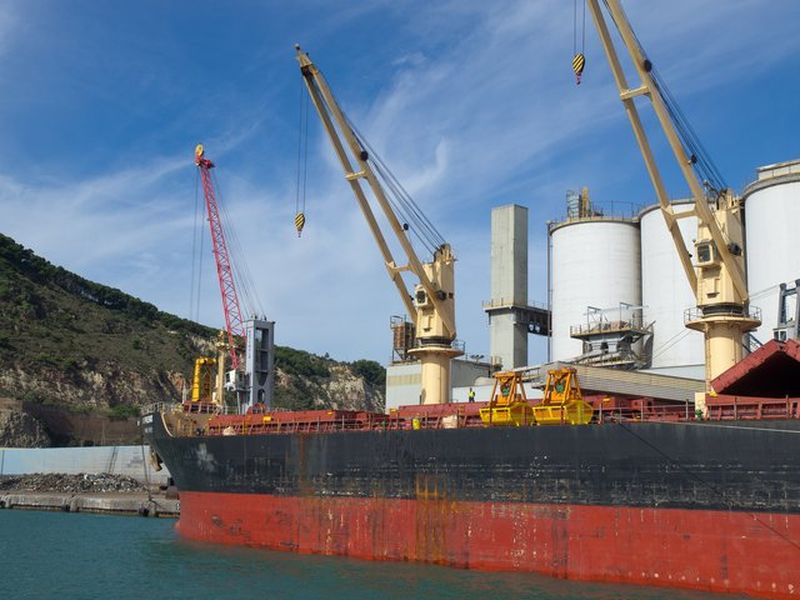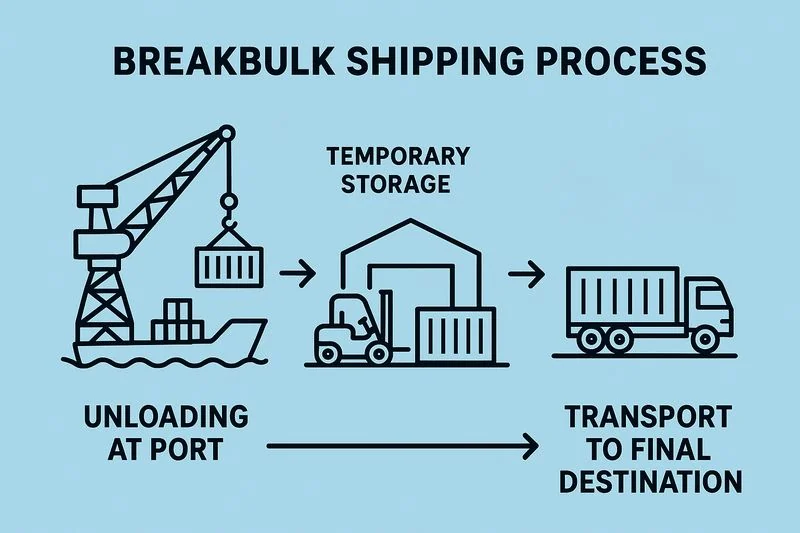Shipping oversized or unusual cargo can be tricky, especially if you want to save money. Breakbulk shipping is the solution for items that don’t fit in standard containers, like car engines, machinery, or construction materials. This guide explains how breakbulk works, what makes it different from regular freight, and how you can move large items efficiently without extra costs.
Table of Content:
- What Does Breakbulk Shipping Mean?
- How Is Breakbulk Different from Bulk Cargo?
- When Should You Consider Breakbulk Shipping?
- What Types of Commodities Are Typically Shipped as Breakbulk?
- How Does Breakbulk Shipping Work?
- What Are the Costs and Challenges of Breakbulk Shipping?
- How Can YK Freight Help With Breakbulk Shipping?
What Does Breakbulk Shipping Mean?
Breakbulk shipping is a method used for transporting cargo that’s too large or unusually shaped to fit into a standard shipping container. Unlike typical containerized cargo, breakbulk items are handled individually. Each piece is loaded, unloaded, and moved using specialized equipment such as cranes, forklifts, or heavy-duty trucks.

For people shipping cars or auto parts, this method is especially relevant. Think of shipping a car engine, a bulky transmission, or even a large industrial machine that simply won’t fit inside a regular container. Instead of trying to squeeze it into standard storage, breakbulk shipping ensures the cargo is handled carefully and delivered safely to its destination.
This method allows shippers to move oversized or awkwardly shaped items efficiently, even if they don’t conform to standard container sizes. For budget-conscious individuals, understanding breakbulk shipping can help in planning shipments that might otherwise seem impossible to send.
How Is Breakbulk Different from Bulk Cargo?
Many people confuse bulk cargo and breakbulk cargo, but they are very different. Bulk cargo refers to loose materials like grains, liquids, coal, or sand that are loaded directly into a ship’s hold, tanker, or container. These items flow freely and don’t require individual handling.
Breakbulk cargo, on the other hand, consists of large or unusually shaped items that cannot be poured or packed into standard containers. This includes machinery, vehicles, steel beams, pipes, and other oversized equipment. Each piece is handled separately, often requiring cranes, forklifts, or other specialized equipment.
The term “breakbulk” actually comes from the idea of “breaking bulk freight” into individual pieces. Instead of shipping all items in bulk, each piece is treated separately and carefully loaded and unloaded.
Here’s a simple way to understand it: if you’re shipping 50 barrels of oil, that’s bulk cargo because the barrels can be stacked and moved together. But if you’re shipping a heavy steel beam or a car engine, that’s breakbulk cargo because each item must be handled individually.
When Should You Consider Breakbulk Shipping?
Breakbulk shipping is ideal when you need to move large, heavy, or unusually shaped cargo that cannot fit into standard containers. It’s particularly useful for shipments over long distances or items that require careful handling. Unlike containerized shipping, breakbulk allows each piece of cargo to be handled individually, ensuring it reaches its destination safely.
There are several advantages to choosing breakbulk shipping:
- Direct delivery – Cargo can go straight from the port to your facility or project site, reducing extra handling and storage steps.
- Fewer steps in transit – Less movement between warehouses and terminals lowers the risk of damage.
- Potentially lower handling costs – By shipping directly and avoiding multiple transfers, you may save money despite the specialized handling requirements.
Here’s a practical example: a small business importing oversized car parts can save money and time by shipping directly from the port to its workshop. Instead of paying for multiple transfers or storage, breakbulk shipping ensures the items arrive safely and efficiently, making it a smart choice for both individuals and businesses dealing with large or irregular shipments.
What Types of Commodities Are Typically Shipped as Breakbulk?
Breakbulk shipping is used for a wide variety of oversized or unusual cargo that can’t fit into standard containers. Some of the most common items include:
- Vehicles and machinery – Cars, trucks, construction equipment, or industrial machines. For example, if you’re transporting a used car bought at an auction, breakbulk shipping ensures it gets from the port directly to your garage safely.
- Pipes and steel structures – Long, heavy materials like construction pipes, steel beams, or framework. These items are too large for container shipping and need specialized handling.
- Engines and oversized equipment – Large engines, turbines, or other industrial equipment that must be moved individually due to size or weight.
- Boxed or crated cargo – Items that are packed in large crates or boxes for protection, such as furniture or delicate machinery.
- Barrels or drums – Heavy liquids or chemicals stored in barrels or drums that require careful handling.
How Does Breakbulk Shipping Work?
Breakbulk shipping involves several careful steps to ensure oversized or unusual cargo reaches its destination safely. Here’s a simple breakdown of the process:
- Unloading at the port – When the ship arrives, breakbulk cargo is removed individually rather than in containers. This often requires cranes, forklifts, or other heavy-duty equipment depending on the size and weight of each item.
- Handling and temporary storage – Once unloaded, the cargo may be temporarily stored at the port or a nearby facility. Each piece is carefully checked to prevent damage during the next stage of transport.
- Transport to the final destination – Specialized trucks or trailers carry the cargo directly to the customer, warehouse, or project site. Oversized items often need additional planning, such as route checks for bridges, weight limits, or special permits.
Planning and coordination are key. Each step must be timed and executed carefully to avoid delays or extra costs.
What Are the Costs and Challenges of Breakbulk Shipping?
Breakbulk shipping can be more expensive than standard container shipping. The main reasons are the special equipment and skilled labor required to handle oversized or unusually shaped cargo. Each item is loaded, unloaded, and transported individually, which takes more time and careful attention compared to regular shipments.
There are also risks and challenges to keep in mind. Breakbulk cargo is often time-sensitive, meaning delays can be costly. Oversized items must be handled carefully to avoid damage, and some shipments may require special permits or route planning for oversized loads.
How Can YK Freight Help With Breakbulk Shipping?
Shipping oversized or unusually shaped cargo doesn’t have to be stressful. YK Freight has years of experience in handling breakbulk shipments, from heavy machinery and car engines to pipes and steel structures. Their expertise ensures that each piece of cargo is managed safely and efficiently from the port to your final destination.
Working with YK Freight brings several benefits:
- Direct delivery – Your cargo can go straight from the port to your garage, workshop, or project site, saving time and avoiding unnecessary handling steps.
- Planning support – They coordinate every detail, from scheduling cranes and forklifts to arranging permits for oversized loads.
- Cost efficiency – Experienced handling reduces the risk of damage, delays, and extra fees, helping you save money in the long run.
For budget-conscious shippers, partnering with a reliable logistics provider like YK Freight ensures a smooth, worry-free shipping experience. Even oversized or tricky shipments can be delivered safely, efficiently, and without breaking the bank.
Further Reading
What is an Intermodal Carrier?
What is the Transloading Process?
When to Use Intermodal Transportation for Cost-Effective Shipping
Discover the Top Benefits of Intermodal Transport for Safe and Cost-Effective Shipping







ASK YOUR QUESTIONS